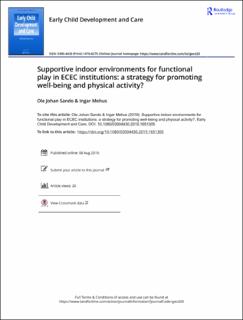Supportive indoor environments for functional play in ECEC institutions: a strategy for promoting well-being and physical activity?
Peer reviewed, Journal article
Published version
Permanent lenke
https://hdl.handle.net/11250/2681052Utgivelsesdato
2019Metadata
Vis full innførselSamlinger
- Artikler (Articles) [173]
- Publikasjoner fra Cristin - DMMH [138]
Originalversjon
Sando, O.J.& Mehus, I. (2019). Supportive indoor environments for functional play in ECEC institutions: a strategy for promoting well-being and physical activity? Early Child Development and Care, 1-12. 10.1080/03004430.2019.1651305Sammendrag
The physical environment in Early Childhood Education and Care (ECEC) institutions provide children with possibilities for play. This study describes a physical environmental intervention aiming to increase the possibilities for functional play in the indoor environment, and its influence on children’s well-being and physical activity. The intervention involved the establishment of a tumbling space with soft surfaces, mats and big construction materials. The sample consists of video observations of 65 children’s free play in seven ECEC institutions at two data points. Multilevel regression analysis indicates that children’s physical activity and functional play is strongly related to the use of a tumbling space, and that the intervention group had a higher increase in functional play following the intervention compared to the control group. The impact of the tumbling space on well-being is limited. The results indicate that targeting children’s possibilities for functional play may be beneficial form a health promotion standpoint.

